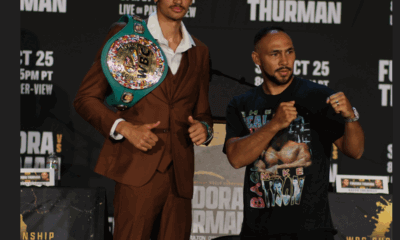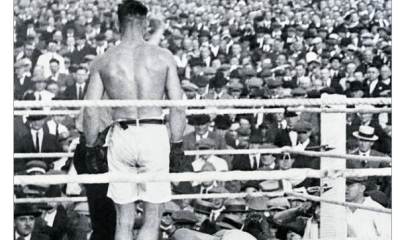Canada and USA
Dr. Margaret Goodman and VADA: Devil or Angel in the PED Era?
There is a hole in this weekend’s schedule. Shannon Briggs and Fres Oquendo were scheduled to fight on Saturday at the Seminole Hard Rock Hotel and Casino in Hollywood, Florida, but the bout was called off when Briggs’ urine specimen showed an abnormally high level of testosterone. Briggs vs Oquendo was yet another casualty of the bogeyman that is VADA. Previous examples include Khan-Peterson, Berto-Ortiz, Wilder-Povetkin, and Povetkin-Stiverne.
VADA stands for the Voluntary Anti-Doping Association. To call it a bogeyman is to stand in league with certain promoters who have seen their well-laid plans go up in smoke because of an adverse test. To others, VADA is the anti-bogeyman. In their view, co-founder Dr. Margaret Goodman, the face of the organization, is less a venomous snake than a knight in shining armor.
Dr. Goodman, a Las Vegas neurologist, earned her medical degree in Chicago, supporting herself as a nightclub singer on weekends, and then returned to UCLA, where she had earned her undergraduate degree, to complete her residency. She was a Las Vegas ring physician from 1994 to 2005, during which time she worked more than five hundred boxing and MMA matches.
Goodman co-founded VADA with her significant other Dr. Edwin “Flip” Homansky in 2011. An internist and emergency medical physician, Homansky (pictured on the left) spent 20 years as a Nevada ringside physician and served two terms as a member of State Athletic Commission until he was swept out the door in November of 2005. During his tenure, the commission became far more stringent in assessing a fighter’s fitness to compete, much to the chagrin of certain promoters who raised a squawk with their political allies. Two months before Homansky was let go, he testified that he had knowledge of “mills” in Mexico where fighters were able to buy an MRI result without taking the scan.
Goodman turned in her resignation as a ringside physician when Gov. Kenny Guinn expelled Homansky from the commission, but she remained with the agency for a few more years in her capacity as the chairman of the medical advisory board. In 2006, the Boxing Writers Association of America honored her and Homansky with the James A. Farley Award for Honesty and Integrity, an award issued sporadically. The duo was recognized for being “staunch advocates for improved boxer safety.”
One could fairly say that Homansky was speaking for the both of them when he told a reporter in 2013 that performance-enhancing drugs were the biggest health crises in sports: “There’s not just a drive to succeed; there is this incredible push to be first, to be better than the person who ran the 100-yard dash last week. With the pressure that brings – from parents, from coaches, from promoters – it is creating an incredible reliance on performance-enhancing drugs….We won’t know the consequences until (the athletes) get older and see what they’ve done to their bodies….We should never acquiesce to letting people artificially stimulate their bodies to improve athletic performance.”
Goodman insists that catching the cheaters was never the primary goal of VADA. Rather, she says, “It’s about preventing athletes from becoming cheaters.” Moreover, one of the more common misconceptions of VADA is that the organization has input in determining the penalty for wrongdoing. “We don’t get involved in any adjudication,” she says emphatically. “Our role is simply to facilitate testing to the highest limit.”
To whom does VADA release the results of a failed drug test? There are six: the boxer and his or her designated representative, the boxer’s opponent and his or her representative, the promoter, the state commission, the international sanctioning body, and BoxRec, an official partner of the Association of Boxing Commissioners. The press is not in the loop. They get their info from one of these entities.
VADA has a great ally in Mauricio Sulaiman, the president of the World Boxing Council. In May of 2016, Sulaiman and Goodman jointly announced the WBC’s Clean Boxing Program, defined as “an integrated program to protect the fighters of the world from the dangers of drugs, PED’s, human growth hormone and several other substances and practices which are hurtful directly and indirectly to the person using them and to their opponents.”
Under the Clean Boxing Program, all WBC champions and all contenders ranked in the top 15 are subject to random, unannounced testing. Those administering the tests and those analyzing the samples must be certified by VADA. The program took effect on Oct. 11, 2016. In addition, participants are required to “attend” the WBC Clean Boxing “web-in-ar,” which anyone may access via the official WBC web site. Among other things, the rather long-winded dissertation contains a list of prohibited substances, many of which can be purchased over the counter at pharmacies in foreign countries.
In 2004, Goodman began writing a monthly column for The Ring magazine. Her column, titled “The Fight Doctor,” continued after the publication was sold to Golden Boy Promotions, but that relationship was doomed from the start. In 2012, former Golden Boy CEO Richard Schaefer told her to take her pen elsewhere. She had previously butted heads with Schaefer over revelations of PED use by several fighters in the Golden Boy stable.
Goodman had first set out to write a novel in 1993. The book would be mothballed. A second stab begat “Death in Vegas,” a novel released by Adam Pollock’s boutique “Win by KO” publishing house in 2014. The blurb for the book describes it as “a medical suspense novel (that) is part Million Dollar Baby, part Rocky, and a bit of Erin Brockovich.”
Aspiring novelists are exhorted to write what they know and Goodman was faithful to this precept. The central character of “Death in Vegas” is Olivia Norris, a shapely, red-headed neurologist in her mid-thirties who moves to Las Vegas from Chicago and worms her way into the Nevada Athletic Commission as a ringside physician as a means to investigate the mysterious circumstances surrounding the death of her brother, a heavyweight contender who has suffered a debilitating and ultimately fatal ring injury.
In the book we meet a big-time boxing promoter who “would sell his children to the network for a well-positioned fight date,” ring physicians who care less about the boxers they are supposed to protect than about getting choice ring assignments, and commissioners with little knowledge of boxing who are guided by the mantra “don’t embarrass the governor.”
Goodman says that writing the book was cathartic.
There are parallels between her book and Budd Schulberg’s 1947 “The Harder They Fall,” the genesis for the 1956 movie of the same name starring Humphrey Bogart. Both explore the seamy underbelly of boxing and press the case for a Federal Boxing Commission.
Goodman believes that the PED mess will never be solved without uniformity and that uniformity is only possible with federal oversight. She also believes that with a national commission there would be fewer instances of boxers extending their careers beyond the point where they are at serious risk of irreversible neurological impairment. “If a fighter has shown deterioration (in his ring skills) and changes in his speech patterns, he must be stopped,” she insists.
There are, needless to say, counter-arguments. Is boxing important enough to warrant a new federal agency and what would prevent the agency from over-reaching with rules and regulations that drown promoters in a sea of bureaucratic red tape? Regarding the question of when a boxer should retire, several writers, notably William Dettloff, have argued that whenever there’s a question about a boxer’s suitability, one should err on the side of personal freedom.
Those that wholeheartedly support the efforts of VADA tend to gloss over the fact that PED testing comes with a price. How expensive is it? We asked Dr. Goodman for a ballpark figure and she came up with $1300 per combatant. That’s for the full gamut of recommended tests drawn from both blood and urine specimens. Because VADA is a non-profit, a promoter can legally write off this expense as a charitable donation but, regardless, there’s no way that a grassroots promoter can absorb this cost and still show a profit. And the sport would founder without grassroots promoters nourishing the roots.
Complicating matters, the long-term effects of PED use are not fully understood. If steroids are all that harmful, one would have thought that Arnold Schwarzenegger, who turns 70 next month, would be a physical wreck by now. He seems to be okay.
The cancellation of Briggs-Oquendo was received as a welcome development in many quarters. Briggs is 45 years old. Oquendo, 44, hasn’t fought in three years. The match was “ill-conceived” said New Jersey boxing writer Keith Idec, which is a sad commentary on the WBA (or a hoot, depending on one’s perspective) considering that the organization had stamped it a world title fight. There was no yelping on the part of the promoter, a fledgling group called The Heavyweight Factory, which was likely relieved to be off the hook as the promotion was assuredly a White Elephant. But inevitably there will be other bouts down the road that bite the dust because of banned substances and some of these will be big fights whose undoing will splay into a far greater brouhaha.
New types of PEDs are developed each year and new masking agents are developed to conceal their use. It’s a cat and mouse game, of sorts. We asked Dr. Goodman if she sometimes felt like Sysyphus, the character in Greek mythology whose eternal fate is to roll a massive boulder up a hill, only to see it roll back down, a sequence repeated again and again. Somewhat surprisingly, despite the frustrations and vilification, she remains optimistic.
“More and more boxers nowadays are demanding they fight only clean opponents,” she says. “They are asking more questions themselves, rather than accepting whatever their coaches tell them. That’s encouraging. Boxing can be a romantic sport. There is no better form of reality television. Boxers give so much of themselves. We owe it to them to keep the sport clean and there’s light at the end of the tunnel.”
Check out more boxing news on video at The Boxing Channel.

-

 Book Review4 weeks ago
Book Review4 weeks agoMark Kriegel’s New Book About Mike Tyson is a Must-Read
-

 Featured Articles3 weeks ago
Featured Articles3 weeks agoThe Hauser Report: Debunking Two Myths and Other Notes
-

 Featured Articles3 weeks ago
Featured Articles3 weeks agoMoses Itauma Continues his Rapid Rise; Steamrolls Dillian Whyte in Riyadh
-

 Featured Articles3 weeks ago
Featured Articles3 weeks agoNikita Tszyu and Australia’s Short-Lived Boxing Renaissance
-

 Featured Articles4 weeks ago
Featured Articles4 weeks agoKotari and Urakawa – Two Fatalities on the Same Card in Japan: Boxing’s Darkest Day
-

 Featured Articles3 weeks ago
Featured Articles3 weeks agoIs Moses Itauma the Next Mike Tyson?
-

 Featured Articles2 weeks ago
Featured Articles2 weeks agoBoxing Odds and Ends: Paul vs ‘Tank,’ Big Trouble for Marselles Brown and More
-

 Featured Articles3 weeks ago
Featured Articles3 weeks agoAvila Perspective, Chap. 340: MVP in Orlando This Weekend




















